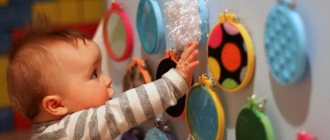Parents who seriously think about the future of their child try to start their education from an early age, using the experience of past teachers who have proven the validity of their views in practice. Nikitin’s methodology, which is aimed at the development and education of children in a playful way, does not lose its relevance.
Goal and tasks
As the Nikitins believed, the key goal of raising a child is the development of a creative personality, and it is on this that the basic principles of the methodology are based. The purpose of the system they developed can be formulated in a similar way.
The objectives of the methodology are:
- harmonious intellectual and physical development of the child from an early age;
- the formation of his independence due to the non-interference of parents in the process of solving a specific problem;
- doing certain exercises helps the child understand colors and basic geometric shapes;
- didactic games are aimed at developing the child’s logic, thinking, and memory in an unobtrusive and easy way.
Many developmental tasks of the Nikitin family appeared during their direct communication with children, with the participation of the latter, and therefore are accessible to children, useful and interesting to them.
Feedback from teachers about the Nikitins’ methodology
The system of experimenters was highly appreciated by famous contemporary teachers:
“The Nikitins’ experience interested me very much, since I pay special attention to issues of improving modern pedagogy and educational processes. Their experimental approach is extremely important for the public education system, and therefore should be studied with special care,” said mathematician and member of the Academy of Sciences Alexei Andreevich Lyapunov.
“The Nikitins showed extreme observation and intuition. Their system is of particular value for disadvantaged children,” said physiologist and academician Ilya Arkadyevich Arshavsky.
“I know the Nikitins’ children and students. These are brilliant problem solvers who know how to find a way out of different life situations, have ingenuity, good speech, and are several grades ahead of the school curriculum,” said Honored Doctor Nikolai Mikhailovich Amosov.
History of creation
The system appeared in the second half of the 60s of the twentieth century and immediately attracted everyone’s attention, since the Nikitins’ approach differed significantly from the norms and principles that reigned in Soviet didactics. The first publication by teachers was published in 1962, and later the proposed innovations attracted the interest of specialists abroad - in Germany and Japan.
The Nikitin methods were developed by those people for whom the problem of raising children was relevant, because the spouses Lena Alekseevna and Boris Pavlovich had seven of them. They not only offered other parents to get acquainted with their own experience, but also, being professional teachers, actively used their knowledge. The Nikitin children began studying mathematics and writing at the age of 3-4 years. The couple tried to raise their children in conditions as close to natural as possible, paid great attention to hardening, physical activity, and provided the children with complete freedom of movement from birth.
Principles of the method in raising children under one year old
The goal of the technique, designed for children under one year of age, is to create the most necessary conditions for the child. This age is more characterized by physiological development, which is the basis for further growth of intelligence. The beginning of the implementation of the Nikitin methods is not even infancy, not childbirth, but all the time from the moment of conception.
The physical development of children under one year of age is the basis for their further intellectual growth
Fundamental nuances of development up to one year
- Family atmosphere. Every child should be desired and raised in love and harmony between parents.
- Pregnancy. During this period, certain conditions must be observed: abstinence from nicotine, alcohol and medications, an active lifestyle for the expectant mother, and mandatory communication with the fetus.
- Childbirth. They should take place without the use of medications, preferably at home. Attachment to the breast occurs immediately after birth (even before the placenta comes out).
- Feeding the baby. Until the first tooth erupts, the baby should receive only breast milk and clean water. Feeding occurs on demand. From the very beginning of introducing complementary foods, there is no need to heat food to a certain temperature.
- Contact with mother. From birth to one and a half years, the child should have contact with his mother as often as possible, including the night period (sleeping together).
- Congenital reflexes. In no case should the development of motor reflexes (crawling, grasping, swimming, attempts to sit independently, walk) be prevented, no matter how early they appear.
- An environment conducive to development. Sports equipment is a natural household item. Availability of construction sets, manipulative games, office supplies (paints, pencils, plasticine, etc.) in constant access.
- Freedom in knowledge. Do not limit the child’s movement or crawling. Playpen - maximum for an hour a day.
- Hardening. From birth, after bathing in warm water, it is necessary to pour cool water over either the entire body or just the baby’s legs.
- Sleeping in the air. In any weather, in any frost, daytime sleep should take place in the fresh air.
- Lack of sterility. Cleaning the premises is very basic. No special sterility.
- Hygiene. In addition to standard daily bathing, the Nikitins trained children to use the toilet from birth, sitting them over a basin even at night.
- Lightweight clothing. It should not hinder movements. At home, where the temperature is about +20 degrees, children walk barefoot and in underwear. Infants do not wear hats indoors; their bodies are exposed to air as much as possible. At the same time, open windows are normal.
- Safety precautions. The best way to let a child understand that an object is dangerous is to allow him to come into contact with it. You will not be able to control your baby 24 hours a day and protect him from, for example, spilling boiling water from a kettle on himself. But if the baby touches something hot and gets a slight pain, he will definitely remember the danger.
As you can see, Nikitin’s methods of raising his children under one year old seem cruel and unsafe. Many modern parents cannot imagine that their child can be outside at a temperature of +10 without a warm hat and full winter gear. Of course, you can panic at the sight of a baby licking a rattle that you washed with soap an hour ago, but you can look at the facts. The facts are that in practice, the Nikitin children always had good health and were ahead of their peers in development.
Advantages and disadvantages
The advantages of the technique include the following.
- This approach allows you to achieve comprehensive physical and intellectual development.
- Helps improve logic, intelligence, spatial thinking, imagination, memory, and the ability to find non-standard paths.
- Teaches kids to be independent, persistent and purposeful from an early age.
- Helps to gain basic knowledge about the most important abstract concepts, which will be useful in the future at school.
It should be noted that the technique is not without its drawbacks.
- Exercises and games are carried out with the interaction of the baby and parents, which, of course, is very useful, but limits the child’s communication with peers.
- The development of a preschooler will not be comprehensive when using only the Nikitins’ methodology, so it should be supplemented with recommendations from other teachers.
- The system is focused on home education, so often children who developed exclusively using this method find themselves unprepared for school life.
- Due to the lack of story-based and role-playing games, the baby does not learn to play; throughout the day he trains his brain, which leads to significant energy expenditure and causes fatigue. Such a child is deprived of many bright moments of childhood.
Let us note that the method has far fewer disadvantages than positive aspects, and they can be easily removed by caring parents who will give their child the opportunity to communicate with peers, play with them the way the child himself wants, and relax.
What should parents do?
How do we do it? Ancestors are always busy: earning money or going about their business. Children grow up on their own with gadgets in their arms. The baby is raised by grandparents or other people's aunts. From the age of 2-3 they are handed over to the state. And depending on your luck.
Parents, do you want to raise a healthy and capable child? So it's up to you! Taking a conscious, thoughtful approach to your responsibilities as a father is your guide. Help the little one take his first steps on the steps of creativity.
The main secrets of development, according to the Nikitin principles:
- While helping the child, the adult himself needs to turn on his brain and get creative;
- try not to be late with development;
- do not impose education;
- support any interest;
- show by personal example “what is good.”
Spouses, create a healthy, loving atmosphere in your home. Caring parents teach children to love work, study, sports and active life.
Organize your home space in such a way as to help your child understand the world around him as much as possible.
So, the house should have:
- fiction and technical books, dictionaries, diagrams, encyclopedia maps for intellectual development;
- smart toys, cubes, construction sets for the development of logical thinking;
- a sports corner equipped with sports equipment for physical education;
- workshop with various tools for developing practical skills.
The presence of all this has a huge impact on the future viability of children, the choice of profession and their path.
Main principles
The spouses explained their position as follows: their task is to educate not geniuses, but self-sufficient and harmonious individuals, who are characterized by a cognitive beginning, keen interest, the desire to create, and the presence of their own position.
The Nikitins’ technique is based on the “three pillars” - fundamental principles.
- Children need special conditions that promote mental and physical development, so parents should carefully consider the design of the children's room: it should be cozy and comfortable. To help your child learn naturally, you can hang cards with letters, an image of a world map, and number tables on the walls.
- The parent’s task is to offer the child a task, but not to impose an approach to solving it, much less the correct answer. The main thing is that the child must show creativity, only in this case the result will be positive. The Nikitin exercises are structured in such a way that several possible solutions are possible.
- Close interaction between the child and his parents is key in the educational process.
Based on these principles and using the developmental benefits of the Nikitins, parents will be able to help their children grow up as harmonious and gifted individuals who do not experience problems in communication and socialization.
How to make a child want to study?
So, the conditions for development must precede this process. This means they need to be prepared in advance. That is, on the walls of the children's room you need to hang a map of the hemispheres, tables of hundreds and thousands, printed and capital letters, measuring instruments, books. And first impressions can involuntarily arouse a child’s interest in some area of knowledge and even develop certain abilities. Working together or working side by side is an obligatory interest in each other’s work process and its results, and at the same time, it is a reason for conversation and exchange of opinions. Here you should pay attention to one very important point: you should never do for a child what he can handle on his own, and never decide for him what he can decide on his own . In any activity for children, adults should try to encourage creativity without imposing their opinions, and without rushing to be sure to prevent a mistake or immediately point out it. And in case of failure, do not reproach or shame the child. But success must be celebrated and not stingy with praise. The main thing is that adults never remain indifferent to what the children do and how they do it, what they do.
Major works
The spouses Lena and Boris Nikitin have written a large amount of educational literature that can be used by modern parents.
Let's list the most famous benefits:
- “The first lessons of natural education, or Childhood without illnesses.”
- "Our lessons."
- "Are we right?"
- "Mind games".
According to their methodology, the child had to begin his education from an early age, and we are talking not only about physical, but also about mental development. That is why all kinds of sports equipment were placed for children, books and visual aids were freely available. At the same time, no one should limit the child’s choice; only he himself could determine what exactly he would do. In modern life, it is quite difficult to fully adhere to this technique, because it is focused on the constant presence of both the child and his mother at home, but parents can safely use elements of intellectual and educational games that will help prepare the child for school, improve his thinking, imagination, and memory.
Physical development
Children must be ready to perceive knowledge not only mentally, but also physically. The child’s body is itself an instrument of learning. Not overloaded with unnecessary clothing, not burdened with super-calorie food, it easily and willingly “meets” the demands of mental order. Sports equipment should be part of a child’s life almost from infancy. The Nikitins paid special attention to hardening. And their experience has shown that this is an effective way to protect a child from most colds.
Best age for classes
Nikitin's complex of educational games can be used for preschoolers of all ages, since by changing the tasks it is easy to increase the level of complexity of the game itself. You can start training with cubes from the age of 1.5 years, this will contribute to the development of fine motor skills. For the little ones, it is enough to use cubes of the same color, simply lay them out, trying to create a “path”. At 3–4 years old, you can safely offer children multi-colored cubes and complicate the task, asking them to put together a pattern.
Basic benefits
The Nikitin spouses’ method involved the comprehensive development of physical strength and endurance, intelligence and creative potential, and therefore included a large number of benefits.
- The wall bars, jump rope, turnstiles, and balls helped the child train his body.
- Cubes, development boards, and puzzles helped improve logical thinking and creativity.
The constructor is also actively used. Working with the benefits is simple - the child is given a specific task that he must complete.
Opening of a new pedagogical law (NUWERS)
Accumulating pedagogical experience in raising his children, Nikitin groped for a new pedagogical law, which he called NUVERS: the irreversible extinction of opportunities for the effective development of abilities. Boris Pavlovich gave a deep justification for it, based on the ideas and research of Amosov, Arshavsky, Grum-Grzhimailo, Descartes, Kapterev, Owen, Pokrovsky, Sarkizov-Serazini, Skripalev, L. Tolstoy, Hiden, Chukovsky, tested and confirmed by the practice of raising his own children. Nikitin developed methods that could prevent the negative impact of this law on the level of intellectual development of future generations.
Mind games
The development of a child’s creativity presupposes the development of his intellect, therefore, in the Nikitin spouses’ method, all kinds of games that are interesting to the child and at the same time useful to him are of great importance. The Nikitins’ method is convenient in that it not only contains theoretical justifications for the rules of working with children, but also offers a set of specific play aids that parents can include in their child’s daily routine. There are many options.
Montessori frames and inserts
This set is intended for children from one year old. It consists of 16 frames and geometric shapes corresponding to them; the child is required to understand which particular shape fits a particular frame and place it “in place.” For the youngest, the task is significantly simplified - they are given the frame itself and a figure (for example, a circle) - the child must understand how to combine them. For children 4-5 years old, you can diversify the exercise - outline both the frames and the inserts, and paint over them.
Unicube
Aimed at developing the child's thinking and attentiveness, it is a set of 27 cubes, the edges of which are painted in different colors. The adult’s task is to give the child a specific task (you can come up with it yourself, for example, build a house out of cubes, stack several cubes so that only the red edges become visible, or look at it in an illustrated instruction book). The educational game will be interesting and useful for children from 1.5 years old. Until the age of three, you can offer the simplest actions, for example, simply placing cubes in a box.
The Nikitins' spouses categorically do not recommend interfering in the process of solving a problem; all that is required from parents is praise for success, and the child must cope with the goal on his own. If adults think that a child is acting “wrongly,” they should still be given creative freedom. There are no wrong decisions, but non-standard ones are quite possible.
Unicube
These are universal cubes that introduce the baby to the world of three-dimensional space. The development of spatial thinking will allow the child in the future to master drawing, stereometry, and descriptive geometry. The game teaches clarity, attentiveness, precision, accuracy.
"Unicube" consists of 27 small wooden cubes. The faces of each cube are painted in such a way (three colors in total) that this combination of faces is rare, if not unique. That is why it is so difficult to complete tasks according to the proposed schemes. Nikitin offers 60 tasks for the “unicube”. The author performed the first of them with children aged 1.5-3 years, and the most complex ones are not accessible to all adults.
Their daughter Anna Ermakova spoke about the Nikitins’ method
"Fold the pattern"
This game set is deservedly popular. It consists of 16 cubes of the same size, the edges of which are painted in four different colors. There are single-color edges, two-color edges in two variations (fragments of different colors are placed diagonally or in a straight line), 3- and 4-color. The child’s task is to put them together into a pattern; at the initial stage, you can use ready-made options from the instruction book, and then use your imagination and come up with all sorts of combinations yourself. The best age to perform exercises with patterns is from 4 to 8 years.
If necessary, you can create a developmental manual yourself using ordinary wooden cubes and colored paper.
Boris Pavlovich Nikitin proposed to follow the path “from simple to complex” and use the following types and forms of work:
- Children aged 1.5-2 years are best at imitating, so an adult can show an example - build a “path”, turret, train or other simple figure from cubes.
- At 2-4 years old, you can safely start working with flowers, inviting your child to repeat a harmonious pattern previously invented by the parent; it can be either a “path” or a “square”. With each lesson, the patterns themselves should become more complex.
The number of “patterns” folded in one game depends on the child’s abilities and desires. For one, 4-5 different variations will be enough, another child will not calm down until he has collected more than 10. The goal of the parents is not to impose their will, but also not to limit the desire.
- A more complicated version of the game is to fold a pattern based on a finished illustration, but change the colors (for example, on a card the picture is blue and white, but the child needs to fold a red and yellow one).
- As soon as the child begins to assemble such complex variations as “saw”, “flashlight”, “slides” without any problems, you should invite him to copy the resulting pattern from the cubes onto a piece of checkered paper.
- Finally, the most difficult form of work is to come up with a pattern by arranging the cubes in the required order, redraw it and paint over it.
The game “Fold the Pattern” is interesting for children, it helps to develop their intelligence, the ability to analyze and synthesize, the ability to think logically, and combine colors and shapes.
"Fold a square"
The didactic material has three levels of difficulty and is a set of 12 squares, each of which is painted in its own color and intricately cut into pieces. The child’s task is simple - to assemble a whole square; he will be required to select “pieces” of the required color and put them together into the correct shape. You can start working with the simplest version of the “Fold a Square” puzzle from the age of two.
You should act according to the principle “from simple to complex”: first invite the child to assemble a square of three parts, then move on to a more complex option - a square divided into 5 or 6 fragments. Finally, the smartest ones can be offered to create a whole from 7 parts.
Fractions
The age range for starting this game varies, from 3 to 5 years. It is a set of three plywood pieces the size of a landscape sheet. Each of them has 4 circles. They all have the same size but different colors. The first circle is whole, the second is cut into two equal parts, the third into three, and so on, up to 12 “slices”. At first, only the first plywood with four circles is left for the game. With their help, you can repeat colors, count the inserted pieces, and compare them with each other. With their help, you can repeat the colors, count the inserted pieces, and compare them with each other. In this way, the child becomes familiar with mathematical terminology. You can try making a multi-colored circle. It is very interesting to build a ladder: at the bottom there is a whole circle, then half, then a third. With its help, you can clearly understand why one second is greater than one third.







